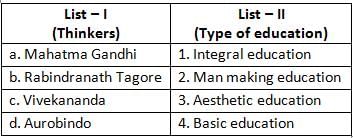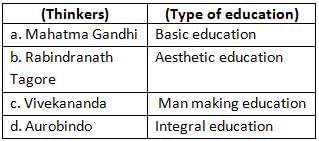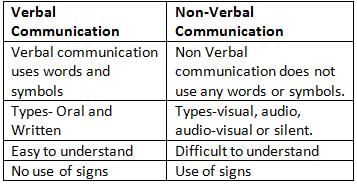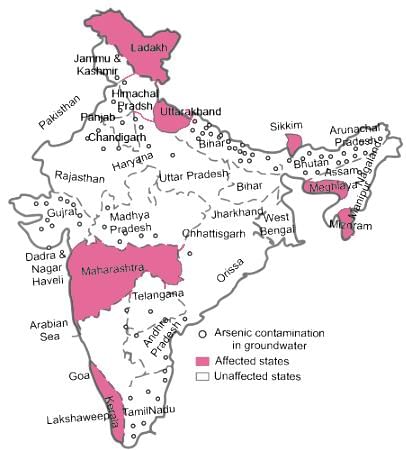UGC NET Paper 1 Mock Test - 5 - UGC NET MCQ
30 Questions MCQ Test UGC NET Mock Test Series 2025 - UGC NET Paper 1 Mock Test - 5
In the context of Gagne's hierarchy of learning, which sequence of teaching methods would effectively guide students from acquiring facts about photosynthesis to applying that knowledge to design a model ecosystem?
Statement 1: In a healthy classroom environment, effective communication should primarily focus on the teacher clearly explaining concepts and delivering information.
Statement 2: Student-to-student interactions and open exchanges of ideas are equally important as teacher-centered instruction for promoting deep learning and critical thinking.
Statement 2: Student-to-student interactions and open exchanges of ideas are equally important as teacher-centered instruction for promoting deep learning and critical thinking.
Which of the following definitions correctly match the logical terms?
- A valid argument is an inductive argument that either is invalid or has at least one false premise.
- A cogent argument is a deductive argument in which the conclusion follows probably from the premises.
- An invalid argument is a set of statements in which a claim (conclusion) is defended with reasons (premises).
- A unsound argument is a deductive argument where the truth of the premises makes the conclusion unlikely or does not strongly support the conclusion.
Choose the correct answer from the options given below:
Which among the following is a globally recognized online learning platform based in the United States?
Which of the following belongs to the Seven Traditions of Communication as per Robert T. Craig
(A). Experimental
(B). Rhetorical
(C). Semiotic
(D). Phenomenological
(E). Physical
Which of the following psychologists are related to socialization in psychology?
(I) Urie Bronfenbrenner
(II) J.P. Guilford
(III) Alfred Binet
(IV)G. H. Mead
If the average total production of wheat in the years 2022, 2023 and 2024 from Rajasthan is 900 and then find 25% of the total production of wheat in the year 2024 from Rajasthan.
The total production of wheat in the year 2023 from Haryana is how much per cent more/less than the total production of wheat in the year 2022 from Punjab.
Choose the correct statement.
Statement I: A child learns more if be taught by computer only.
Statement II: A child learns more if be taught by the child-centred method.
The Manusmriti, an ancient Indian legal text, primarily offers guidance on:
Choose the correct statement regarding the impacts of dehydration on human health.
Which of the following statements is incorrect regarding maintaining hydration?
Which of the following factors is not a factor that affects mediated persuasion?
1- The source's credibility
2- The message's content
3- The message's presentation
4- The audience's characteristics
Choose the correct answer from the options given below:
What is the importance of Art Education at elementary level in schools?
Students are inattentive in the classroom. The reason is:
Which of the following are key objectives of the United Nations Framework Convention on Climate Change (UNFCCC)?
A. Stabilization of greenhouse gas concentrations in the atmosphere
B. Ensuring food security at global level
C. Prevention of ozone layer depletion
D. Assisting developing countries to implement practices to mitigate climate change
E. Promoting the use of fossil fuels in industrial processes
Choose the correct answer from the options given below:
Given below are two statements, one is labeled as Assertion A and the other is labeled as Reason R
Assertion A: The CBCS method employs credits instead of the traditional marking system.
Reason R: CBCS places a strong emphasis on group discussions, assignments, class activities, and internal assessments, resulting in a positive learning atmosphere.
From the list given below, identify the Psychological barriers to communication
(A) Noise
(B) Invisibility
(C) Prejudice
(D) Disinterest
(E) Inattention
Choose the most appropriate answer from the options given below :
Given below are two statements :
Statement I: A presentation is a non-verbal means of communication.
Statement II: Different components of the presentation that attract the attention of the audience are Attention grabbers.
In the light of the above statements, choose the most appropriate answer from the options given below:
In the Tarkashastra (the Indian theory of logic), what is the fallacy called where the middle term does not exist in reality?
Given below are two statements :
Statement I : Academicians from hundreds of institutions throughout India are involved in developing & delivering MOOCs through the SWAYAM program
Statement II Swayam provides one integrated platform and portal for online courses. This covers all higher education subjects and skill sector courses.Given below are two statements :
Statement I: The states of West Bengal, Jharkhand, Bihar, Uttar Pradesh, Assam are reported to be most affected by arsenic contamination
Statement II: Long-term exposure to arsenic in drinking water is causally related to increased risks of cancer in the skin, lungs, bladder, and kidney
In the light of the above statements, choose the most appropriate answer from the options given below:
|
92 docs|125 tests
|


















